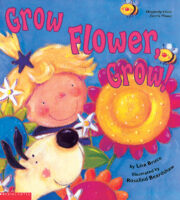5 Books and 1 Craft About Spring to Teach Plant Growth and Development
Titles to get your classroom excited about spring and what the season brings.
5 Books and 1 Craft About Spring to Teach Plant Growth and Development
From April showers to May flowers, these 5 spring books for kids—and 1 creative spring-inspired craft—will teach your students everything they need to know about plant life cycles, growth, and development.
Spaghetti, pizza, and ice cream might be tasty, but they’re no help when it comes to growing flowers. In this entertaining book about spring, your students will learn that rain, wind, and sunshine are what beautiful flowers truly crave.
This beautiful book shows students all the wonderful things that happen when winter turns to spring.
In this humorous book, young readers not only learn about plant growth and development, they find out just how important patience is when it comes to transforming the world.
- What You Need:
- Green and yellow crayons
- Tacky glue or hot glue
- Thick white paper or card stock
- Blow dryers
- Craft flower tops
- Sheets of scrap cardboard (larger than the sheets of white paper)
- Crayons, markers, tissue paper, or other craft materials for building flowers
After reading a few of these children’s books about spring, encourage your students to get creative and crafty with this spring-inspired activity!
Melted-Crayon Spring Garden Craft
With this timely spring craft, your students will transform their crayons into a beautiful spring garden.
- What You Do:
- Instruct students to peel all of the paper wrapping off the green and yellow crayons.
- Next, help your students glue the green and yellow crayons in a line along the bottom of their sheets of white paper, alternating colors and using more green than yellow.
- Ask your students to prop the paper upside down so that the crayons are at the top of the paper, points facing down. Have them lay the paper on top of a piece of scrap cardboard. Note: You should try to rest the cardboard and paper on a slanted easel or against something solid, such as a chair, table, or wall.
- Now, help your students use a blow dryer to melt the crayon wax, letting it drip down the paper at different lengths to create grass and longer flower stems.
- Have your students lay the paper flat to let the melted wax cool. They should be very careful not to touch the wax until it is completely cool!
- Finally, encourage your students to glue the craft flowers to the tops of the stems to create a garden.
Note: The size of the white paper will determine the number of crayons each student will need. To reduce the number of crayons used, cut the white paper into smaller sizes. Four crayons side-by-side take up approximately 1.25 inches.
Note: You can provide craft materials instead of pre-made flower tops if your students want to draw or fold their own flowers.
Other Books You Might Like




